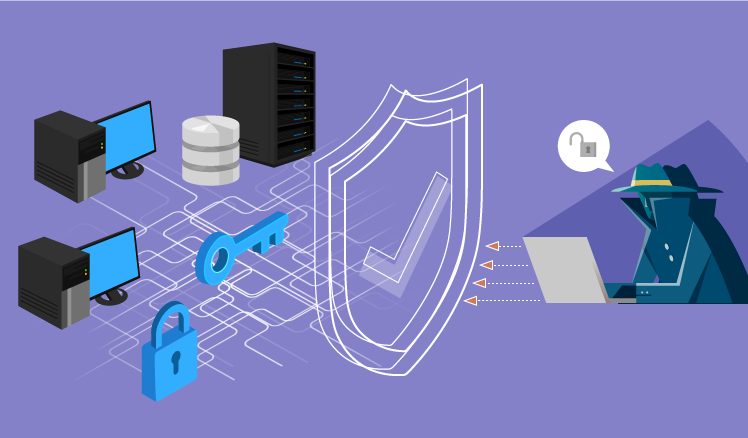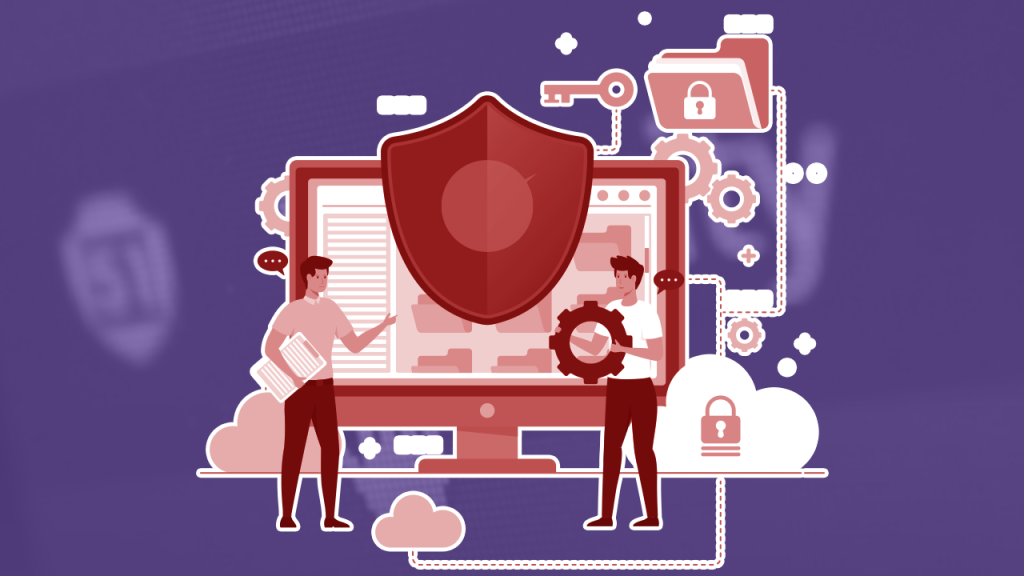Written By:
Scott McAuley
Welcome to my blog! I am a recognized expert in SMB IT solutions with over 25 years of experience as a Technology Executive. My expertise includes IT strategy, digital transformation, and optimizing IT operations to drive business growth. I specialize in leading IT teams, enhancing cybersecurity, and delivering innovative technology solutions that improve efficiency and performance. If you’re looking to explore IT strategies or need expert guidance on digital transformation and technology implementation, connect with me. Let’s collaborate to leverage technology for your business success. Reach out today!
Did you know that cyberattacks on businesses have increased by a staggering 400% in the past year alone?
As organizations become increasingly digitalized, network security plays an essential role in protecting valuable assets, data, and information. Network Security as a Service (SECaaS) offers a revolutionary approach to fortifying your IT defense.
By outsourcing network security to a trusted service provider, you can harness expert knowledge, utilize advanced technologies, and benefit from real-time protection. In this article, we will delve into the concept of Network Security as a Service and explore its mastery in empowering your IT defense.
Key Takeaways
- Network Security as a Service (SECaaS) offers cloud-based solutions that allow businesses to outsource network security management, providing real-time protection without the need for in-house infrastructure.
- Key features of Security as a Service include automation for threat detection, enhanced IoT/OT security, and Zero Trust capabilities, ensuring comprehensive protection against evolving cyber threats.
- Security as a Service is crucial in today’s digital landscape, offering scalable, cost-effective solutions that enhance threat detection, incident response, and compliance management for businesses of all sizes.
- SECaaS provides scalability, cost-effectiveness, rapid deployment, continuous updates, and enhanced protection, allowing organizations to focus on core operations while maintaining robust security defenses.
- Emerging technologies like AI, cloud-based security, IoT integration, blockchain, and quantum computing are shaping the future of Security as a Service, offering innovative solutions for advanced cybersecurity.
Table of Contents
What is Network Security as a Service?

Network Security as a Service (SECaaS) is a cloud-based security solution that allows organizations to outsource their network security management and monitoring to a third-party service provider.
By embracing SECaaS, businesses can eliminate the need for in-house security infrastructure and expertise while benefiting from comprehensive network security services. This approach ensures real-time protection against evolving cyber threats and provides a cost-effective solution for enhancing IT defense.
SECaaS encompasses a range of security features, including firewall management, intrusion detection and prevention, secure web gateways, and virtual private networks (VPNs). These cloud-based security services work together to protect the confidentiality, integrity, and availability of data transmitted over the network.
By leveraging SECaaS, organizations can take advantage of advanced technologies and expert knowledge provided by the service provider. This allows them to stay updated with the latest security measures and best practices without the hassle of managing and maintaining their own security infrastructure.
With real-time protection and proactive threat detection, SECaaS empowers businesses to mitigate the risks associated with cyber threats and safeguard their critical assets and information.
What is Network Security?
Network security is the practice of securing a computer network from unauthorized access, misuse, and cyber threats. It involves implementing measures to protect the confidentiality, integrity, and availability of data transmitted over the network.
Network security aims to prevent unauthorized access to information, protect against data breaches and cyberattacks, and ensure the smooth operation of network resources.
3 Features of Security as a Service
Security as a Service offers several features that enhance network security and provide an advanced defense against cyber threats.
These features include:
| Feature | Description |
|---|---|
| Automation | Streamlines and accelerates security processes, enabling real-time threat detection and response. |
| Enhanced IoT/OT Security | Provides comprehensive security measures for IoT and OT devices, including monitoring, vulnerability assessment, and intrusion detection. |
| Zero Trust Capabilities | Enables granular access controls, multi-factor authentication, and continuous monitoring to prevent unauthorized access. |
1. Automation
Automation is a key feature of Security as a Service that streamlines and accelerates security processes. With automated threat detection and response capabilities, organizations can proactively identify and mitigate potential risks in real-time, reducing the impact of cyber attacks. Automation also enables efficient security management, freeing up resources and allowing IT teams to focus on strategic initiatives.
2. Enhanced IoT/OT Security
Security as a Service provides enhanced security measures for Internet of Things (IoT) and Operational Technology (OT) devices. This includes comprehensive monitoring, vulnerability assessment, and intrusion detection to protect against threats targeting IoT and OT infrastructure. By strengthening the security of these interconnected systems, organizations can mitigate the risk of unauthorized access, data breaches, and disruption to critical operations.
3. Zero Trust Capabilities
Zero Trust is a security approach that requires organizations to verify and authenticate every device, user, and application attempting to access their network infrastructure, regardless of their location.
Security as a Service incorporates Zero Trust capabilities, enabling organizations to establish granular access controls, implement multi-factor authentication, and continuously monitor network traffic for any suspicious activity. This helps prevent unauthorized access and provides a more robust defense against advanced threats.
Importance of Security as a Service

Security as a Service (SECaaS) is crucial in today’s digital landscape as it offers scalable, cost-effective solutions to combat evolving cyber threats. By outsourcing security functions to specialized providers, organizations can access advanced technologies, expertise, and round-the-clock monitoring without heavy upfront investments.
SECaaS enhances threat detection, incident response, and compliance management, bolstering overall cybersecurity posture. It enables businesses to focus on core operations while ensuring robust protection against data breaches, malware, and unauthorized access.
With SECaaS, organizations can adapt quickly to emerging threats, mitigate risks effectively, and maintain trust with customers, partners, and regulatory authorities in an increasingly interconnected world.
Types of Network Security as a Service
Network Security as a Service encompasses various types of security services that can be outsourced to a third-party provider. By leveraging these services, businesses can strengthen their network security and protect their valuable assets.
Some common types of network security as a service include:
| Type of Network Security as a Service | Description |
|---|---|
| Firewall Management | Outsourcing firewall configuration, monitoring, and maintenance to ensure network protection against unauthorized access. |
| Intrusion Detection and Prevention | Real-time monitoring and advanced technologies to detect and prevent unauthorized activities within the network. |
| Secure Web Gateways | Protection against web-based threats such as malware, phishing attacks, and other malicious activities. |
| Virtual Private Networks (VPNs) | Secure remote access to networks and data through encrypted network connections. |
- Firewall Management: Outsourcing firewall management allows organizations to ensure their network remains protected against unauthorized access. Expert professionals handle the configuration, monitoring, and maintenance of firewalls to prevent potential security breaches.
- Intrusion Detection and Prevention: With intrusion detection and prevention as a service, organizations can stay one step ahead of cyber threats. This service utilizes advanced technologies and real-time monitoring to detect and prevent unauthorized activities within the network.
- Secure Web Gateways: Secure web gateways as a service provide protection against web-based threats such as malware, phishing attacks, and other malicious activities. By routing internet traffic through secure gateways, organizations can filter out potential threats and ensure secure access to the web.
- Virtual Private Networks (VPNs): VPNs as a service enable secure remote access to networks and data. By encrypting network connections, organizations can provide employees with a secure means of accessing company resources, even when working remotely.
7 Benefits of Security as a Service
Security as a Service offers several benefits for organizations looking to enhance their network security.
These benefits include:
| Benefit | Description |
|---|---|
| Scalability | Organizations can easily scale their network security solutions with Security as a Service, meeting changing needs without significant infrastructure upgrades. |
| Cost-Effectiveness | Security as a Service offers a cost-effective alternative to in-house network security, shifting management and maintenance burdens to service providers, reducing capital expenditure and ongoing costs. |
| Accessibility | Security as a Service allows remote monitoring and management of security systems, providing accessibility from anywhere, anytime, enabling swift responses to emerging threats. |
| Rapid Deployment | Rapid deployment capabilities of Security as a Service enable quick implementation of robust security measures, valuable for immediate protection needs during incident response or system onboarding. |
| Continuous Updates and Upgrades | Security as a Service provides continuous updates and upgrades, ensuring access to the latest security solutions and protection against emerging threats without manual intervention. |
| Enhanced Protection | Outsourcing network security to specialized providers enhances protection against a wide range of threats, leveraging advanced technologies and real-time monitoring to mitigate risks proactively. |
| Compliance Assistance | Security as a Service providers often offer compliance assistance, helping businesses navigate regulatory requirements to maintain compliance while benefiting from robust network security. |
1. Scalability
With Security as a Service, organizations can easily scale their network security solutions to meet their changing needs. As businesses grow and expand their operations, the flexibility of Security as a Service allows for seamless scalability without the need for significant infrastructure upgrades or modifications.
2. Cost-Effectiveness
Implementing and maintaining an in-house network security infrastructure can be costly, requiring substantial upfront investments and ongoing expenses. Security as a Service offers a cost-effective alternative by shifting the burden of infrastructure management and maintenance to the service provider. This eliminates the need for capital expenditure while providing access to advanced security technologies and expertise.
3. Accessibility
With Security as a Service, organizations can benefit from network security solutions that are accessible from anywhere, anytime. This accessibility enables remote monitoring and management of security systems, allowing businesses to respond swiftly to emerging threats and ensure the protection of their network infrastructure.
4. Rapid Deployment
Security as a Service offers rapid deployment capabilities, allowing organizations to quickly implement robust security measures without lengthy setup and configuration processes. This is particularly valuable in situations where immediate protection is required, such as during incident response or when onboarding new systems or applications.
5. Continuous Updates and Upgrades
Network security threats are ever-evolving, requiring organizations to stay up to date with the latest security measures and technologies. Security as a Service provides continuous updates and upgrades, ensuring that businesses have access to the most advanced security solutions and protection against emerging threats without the need for manual updates.
6. Enhanced Protection
By outsourcing network security to a specialized service provider, organizations can benefit from enhanced protection against a wide range of security threats. Security as a Service leverages advanced technologies, threat intelligence, and real-time monitoring to detect and mitigate threats before they can cause harm to the network infrastructure or compromise sensitive data.
7. Compliance Assistance
Compliance with industry regulations and data protection standards is critical for organizations in various sectors. Security as a Service providers often offers compliance assistance, helping businesses navigate the complex landscape of regulatory requirements. This ensures that organizations maintain compliance while benefiting from robust network security measures.
5 Challenges of Security as a Service
While Security as a Service (SECaaS) offers numerous benefits, it also presents certain challenges that organizations must consider.
These challenges include:
| Challenge | Description |
|---|---|
| Connectivity Reliance | Organizations must rely on stable and secure internet connectivity for continuous protection. |
| Data Privacy Concerns | Protecting sensitive data and complying with data privacy regulations are key considerations. |
| Limited Customization | Organizations may face limitations in customizing security measures to meet unique requirements. |
| Vendor Lock-In | Switching providers or making changes to security infrastructure can be challenging and costly. |
| Security Concerns | Organizations may have concerns about the overall effectiveness and reliability of the service. |
1. Connectivity Reliance
One of the challenges of implementing Security as a Service is the reliance on connectivity. As SECaaS is delivered over the internet, organizations need a stable and secure internet connection to ensure continuous protection. Any disruptions in connectivity could leave the organization vulnerable to cyber threats.
2. Data Privacy Concerns
Data privacy is a paramount concern for organizations when outsourcing their security to a third-party provider. Businesses must ensure that their sensitive data, intellectual property, and customer information are handled and protected properly. Regulatory compliance and data protection laws play a crucial role in mitigating data privacy risks.
3. Limited Customization
When adopting Security as a Service, organizations may face limitations in customizing security measures according to their specific requirements. The level of customization available may vary between different SECaaS providers, restricting organizations from implementing tailor-made security solutions that align with their unique needs.
4. Vendor Lock-In
Vendor lock-in is a concern when relying on a single SECaaS provider for all network security needs. Organizations may find it challenging to switch to a different provider or make changes to their security infrastructure without incurring significant costs or disruptions. It is essential to carefully evaluate vendor contracts and ensure flexibility for future growth and adjustments.
5. Security Concerns
While SECaaS aims to enhance network security, organizations may still have concerns about the overall effectiveness and reliability of the service. Trusting a third-party provider with critical security responsibilities raises questions about potential vulnerabilities, cyber threats, and response capabilities. Regular performance monitoring and ongoing communication with the provider are crucial to address these concerns.
13 Examples of Security as a Service
Security as a Service encompasses various solutions and services that organizations can utilize to enhance their network security.
Here are some examples:
- Business Continuity and Disaster Recovery (BC/DR or BCDR): Ensures organizations can continue operations and recover swiftly from disasters or disruptions. It involves strategies, processes, and technologies to minimize downtime and data loss.
- Antivirus Management: Involves deploying and managing antivirus software across an organization’s network to detect, prevent, and remove malware infections from systems and devices.
- Intrusion Protection: Protects networks and systems from unauthorized access, cyberattacks, and malicious activities by monitoring, detecting, and blocking suspicious or malicious network traffic.
- Data Loss Prevention (DLP): Focuses on preventing unauthorized access, transfer, or disclosure of sensitive data within an organization. It involves monitoring and enforcing policies to protect data from being lost or stolen.
- Security Assessment: Involves evaluating an organization’s security posture to identify vulnerabilities, weaknesses, and risks. It includes conducting security audits, assessments, and penetration tests to identify and address security gaps.
- Identity and Access Management (IAM): Manages and controls user access to systems, applications, and data within an organization. IAM solutions authenticate users, enforce access policies, and manage user identities and privileges.
- Email Security: Protects organizations from email-based threats such as phishing, malware, spam, and spoofing. It involves implementing security measures such as email filtering, encryption, and authentication to secure email communications.
- Vulnerability Scanning: Involves scanning networks, systems, and applications to identify security vulnerabilities and weaknesses. Vulnerability scanning helps organizations prioritize and remediate security issues to reduce the risk of exploitation.
- Web Security: Secures web applications, websites, and web services from cyber threats and attacks. It includes measures such as web application firewalls, secure coding practices, and content filtering to protect against web-based attacks.
- Continuous Monitoring: Involves real-time monitoring of networks, systems, and applications to detect and respond to security threats and incidents promptly. Continuous monitoring helps organizations identify and mitigate security risks proactively.
- Security Information and Event Management (SIEM): Collects, analyzes, and correlates security event data from various sources to provide insights into security threats and incidents. SIEM solutions help organizations detect, investigate, and respond to security incidents effectively.
- Spam Filtering: Filters and blocks unsolicited or unwanted emails, such as spam and phishing emails, from reaching users’ inboxes. Spam filtering helps organizations reduce the risk of email-based threats and improve email security.
- Network Security: Protects networks from unauthorized access, data breaches, and cyberattacks. Network security solutions include firewalls, VPNs, intrusion detection systems (IDS), and other technologies to safeguard network infrastructure and data transmissions.
What do you Look for in Security as a Service Provider?
When choosing a Security as a Service solutions provider, organizations should consider several factors to ensure they partner with a reliable and capable service provider.
Some key things to look for include:
| Factor | What to Look for |
|---|---|
| Cybersecurity Expertise | Provider with strong foundation in cybersecurity and deep understanding of network security principles. |
| Industry Experience | Provider with extensive experience in your industry to better understand your specific security needs and challenges. |
| 24/7 Support | Provider that offers round-the-clock support to address any network security issues promptly. |
| Compliance Capabilities | Provider with necessary compliance capabilities to meet your industry regulations and standards. |
- Cybersecurity Expertise: Find a provider that has a strong foundation in cybersecurity and a deep understanding of network security principles.
- Industry Experience: Look for a provider with extensive experience in your industry, as they will have a better understanding of your specific security needs and challenges.
- 24/7 Support: Network security threats can occur at any time, so it is important to choose a provider that offers round-the-clock support to address any issues or incidents promptly.
- Compliance Capabilities: Depending on the nature of your business, compliance with industry regulations and standards may be critical. Ensure that the provider has the necessary compliance capabilities to meet your requirements.
Future Trends and Emerging Technologies
The field of Security as a Service is continuously evolving, driven by emerging technologies and evolving cyber threats. As organizations navigate the ever-changing landscape of network security, it is important to stay informed about the future trends and emerging technologies that will shape the industry.
By understanding these advancements, businesses can proactively adapt their security strategies to mitigate risks and safeguard their digital assets.
| Future Trends and Emerging Technologies |
|---|
| The Rise of Artificial Intelligence (AI) in Network Security |
| The Growing Importance of Cloud-Based Security |
| The Integration of IoT Security |
| Blockchain for Enhanced Data Security |
| The Advent of Quantum Computing |
- The Rise of Artificial Intelligence (AI) in Network Security: AI-powered technologies are revolutionizing the way network security is managed. Machine learning algorithms can analyze vast amounts of data to detect patterns and anomalies, enabling real-time threat detection and response. AI also plays a crucial role in automating security operations and predicting future cyber threats, allowing organizations to stay one step ahead of malicious actors.
- The Growing Importance of Cloud-Based Security: With the increasing adoption of cloud computing, organizations are relying on cloud-based security solutions to protect their networks and data. Cloud-based security offers scalability, flexibility, and cost-effectiveness, allowing businesses to easily scale their security measures to meet their evolving needs. Additionally, cloud-based security providers often have dedicated teams of experts who ensure continuous monitoring and timely upgrades, enhancing overall network protection.
- The Integration of IoT Security: As the Internet of Things (IoT) continues to expand, securing IoT devices and networks becomes a critical priority. Security as a Service providers are incorporating enhanced IoT security measures to protect against IoT-specific vulnerabilities and threats. This includes implementing strong access controls, encryption protocols, and device authentication mechanisms to ensure the integrity and privacy of IoT data.
- Blockchain for Enhanced Data Security: Blockchain technology, known for its decentralized and immutable nature, has the potential to revolutionize network security. By leveraging blockchain, organizations can establish tamper-proof data records, enhance authentication and identity management, and enable secure peer-to-peer communication. This emerging technology offers increased transparency, data integrity, and resistance against cyber attacks.
- The Advent of Quantum Computing: While quantum computing presents new opportunities for innovation, it also poses significant challenges for network security. As quantum computers become more powerful, they have the potential to break many of the encryption algorithms used today. To address this, security experts are exploring quantum-resistant cryptography and quantum key distribution techniques to ensure the future security of networks and data.
Conclusion
Network Security as a Service offers organizations the opportunity to reinforce their IT defense with expert knowledge, advanced technologies, and real-time protection. By outsourcing network security to a service provider, you can stay ahead of evolving cyber threats and ensure a robust network security protection.
From automated threat detection to enhanced IoT/OT security, Security as a Service provides a comprehensive approach to network security. Embracing the mastery of Security as a Service empowers businesses to protect their digital assets, safeguard sensitive information, and thrive in the digital age.
By implementing a robust IT defense strategy through Security as a Service, you demonstrate your commitment to safeguarding sensitive information and maintaining the integrity of your network. With network security as a service mastery, you can confidently navigate the digital landscape, knowing that your organization is protected against cyber threats and poised for growth.
Empowered by the Insights on Network Security as a Service?
Keep the momentum going at texmg.com! Explore our diverse blogs for deeper knowledge and discover cost-effective IT services tailored to fortify your defenses.
Elevate your IT defense – explore with us today!
FAQ
What is the Meaning of Security as a Service?
Security as a service refers to the delivery of security solutions and capabilities via a subscription model, typically hosted and managed by a third-party provider, to protect organizations from cyber threats and vulnerabilities.
What is Cybersecurity as a Service?
Cybersecurity as a service (CaaS) provides organizations with outsourced cybersecurity solutions, including threat detection, incident response, vulnerability management, and compliance monitoring, offered as a subscription-based service.
What is Network Security and an Example?
Network security involves implementing measures to protect a computer network from unauthorized access, misuse, or modification. An example is using firewalls, intrusion detection systems, and encryption protocols to safeguard network traffic.
What is the Main Purpose of Security Services?
The main purpose of security services is to safeguard an organization’s assets, data, and operations from cyber threats, breaches, and vulnerabilities, ensuring confidentiality, integrity, and availability of information and systems.






